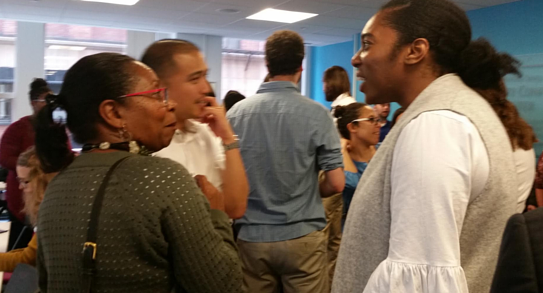I recently had a conversation with a friend and colleague about what I perceive to be a revolution in progress. Grant makers and nonprofit professionals are now talking openly about some very painful (and inter-related) issues in philanthropy, such as
- The lack of inclusion and equity in philanthropy.
- The difficult power dynamics among grantors and grantees.
- The origins of some foundations’ wealth, which in some cases includes slavery and other forms of exploitation.
- The tendency of philanthropic professionals, big donors, and other relatively privileged people to assume that they know what is best for the people who are directly affected by the problems that need to be addressed.
It is really inspiring to see philanthropic and nonprofit professional engaging in public conversations about these challenges, and even more inspiring to see them taking action to create positive changes. I offered to send my friend and colleague a list of key articles and books about this revolution, and it now occurs to me that I can share this list with everyone who is interested. Here it is:
Books:
- Decolonizing Wealth: Indigenous Wisdom to Heal Divides and Restore Balance
- Winners Take All: The Elite Charade of Changing the World
- Just Giving: Why Philanthropy Is Failing Democracy and How It Can Do Better
- Giving Done Right: Effective Philanthropy and Making Every Dollar Count
- Unicorns Unite: How nonprofits and foundations can build EPIC Partnerships
- The Revolution Will Not Be Funded: Beyond the Non-Profit Industrial Complex
- From Generosity to Justice: A New Gospel of Wealth
- Philanthropy Reconsidered: Private Initiatives – Public Good – Quality of Life
- The Givers: Money, Power, and Philanthropy in a New Gilded Age
Articles, reports, podcasts, and videos:
- The Problems With Philanthropy, and What We Can Do to Fix Them
- In the March Toward Equity and Justice, Foundations Need to Remember: It’s Not Our Money to Control
- Social Change Won’t Happen Unless Philanthropy Gives More Power to Grassroots Leaders
- It’s Time For Philanthropic Billionaires To Share Power
- Deciding Together Shifting Power and Resources Through Participatory Grantmaking
- Philanthropy is at a turning point. Here are 6 ways it could go
- No Time for Complacency: Preparing Foundations for a More Turbulent Future
- Letting grantees lead: What we’re learning from the BUILD evaluation
- Empowering Communities: Participatory Grantmakers Say We Must Go beyond Feedback
- A Place Where You Can Speak Your Mind to That Foundation
- Center for Effective Philanthropy: Grantee and Applicant Perception Reports
- The state of grant seeking
- What if pizza shops were funded like human service nonprofits?
- Do we know best what others need?
- Solutions Privilege: How privilege shapes the expectations of solutions, and why it’s bad for our work addressing systemic injustice
- A Call to Modernize American Philanthropy
- Decolonizing Wealth – Nonprofit Radio Podcast
- Good People, Hidden Biases, and Navigating Your Blind Spots
- Can Philanthropic Money Listen? Some observations from Atlanta.
- More than money: philanthropists as activists
- Transparency: One Small Step for Funders, One Giant Leap for Equity
- Reimagining Our Vision & Value to the Field
- The US is growing more unequal. Some say philanthropy isn’t the solution.
- Are the New Megadonors Distorting American Society?
- As Distrust in Big Philanthropy Grows, Here’s How Leading Foundations Are Demonstrating Their Value
- Answers on grant proposals if nonprofits were brutally honest with funders
- On Not Being Constrained by the System You’re In
- Choosing to be a Liberated Gatekeeper
- The 2018 Diversity Among Philanthropic Professionals Report: A Tale of Two Sectors
- Why Impact-Per-Dollar is a terrible, harmful way to measure nonprofit effectiveness
- The Power of Dialogue about Nonprofit Data and Evaluation
- Joint Statement of Associations Advancing Equitable Evaluation Practices
- Insights from an Equity, Diversity, and Inclusion Journey
- Announcing the first foundation assessment guide on power and privilege
- Philanthropy for change, not charity
- How Philanthropy Can Get Serious About Racial Healing
- ‘You Can’t Lift People Up by Putting Them Down’: How to Talk About Tough Issues of Race, Poverty, and More
- Inching Toward Equity: Grant makers want to be sure their giving does more to benefit people of color, but progress is slow
- Results Count: The Path to Equity
- Showing Up with an Equity Lens
- Race, Equity and Boston
- The Smartest Way to Promote Diversity: Pay for Overhead at Charities Led by People of Color
- How corporate foundations and CSR need to evolve to be more effective partners with nonprofits
- Employee Pressure Will Help Redefine CSR in 2019
- Lessons Learned from Two Decades in Philanthropy
- Moving People Forward: How Equity Leads to Greater Progress
- You’re not serious about equity if you don’t post salaries
- Survey: Nonprofits Struggle with Demonstrating Outcomes
- Evaluating a Culture
- Get a BEER* and Undo Nonprofit Power Dynamics Day
- Can Power Be Anything But Zero-Sum?
- Self-Interest (Rightly Understood) in the Nonprofit Sector
- You can’t give from an empty cup: Funders can enable movements to flourish by helping grantees reduce burnout
- Race to Lead: Confronting the Nonprofit Racial Leadership Gap
- Diversifying Boards Means Ceding Control—Are White Nonprofit Leaders Ready?
- Trust in Grantees, Not Command and Control
- Trust-based grantmaking: What it is, and why it’s critical to our sector
- Trust-Based Philanthropy Project
- How Foundations Can Grapple With the Reality That Their Wealth Was Accumulated Unjustly
- Kids Choose Their Donors in a Twist on Sponsorships
- How funder fragility is similar to white fragility and what funders can do about it
- As Foundations Reimagine Themselves, They Should Give Attention to DEI in Operations
- The Challenge of Nonprofit Leadership: Navigating a Perilous Moment
- Nonprofits Struggle to Implement Diversity Measures, Survey Finds
- Nonprofits that empower leaders of color are more apt to do something about racial inequality
- Why more and more executive directors of color are leaving their positions, and what we need to do about it
- Report Identifies Barriers to Nonprofit Advancement for Women of Color
- What Does It Look Like to Support Women of Color to Lead?
- Leaders of Color Speak Out…about being underestimated, breaking barriers, and whether things are getting better.
- White Men Still Dominate CEO Offices at Big Charities
- Fund The People: Talent Justice Initiative
- Undoing Power Dynamics in the Nonprofit Sector – Two Perspectives
- We Need to Talk About ‘The Giving Tree’
- Systems Change Is All about Shifting Power
- Who are our nonprofit disruptors and instigators?
- Momentum for Change: Ending the Nonprofit Starvation Cycle
- Making Amends: How Funders Can Address Slavery’s Legacy
- Real Equity Means Including People With Disabilities in Philanthropy
- Belonging In The Workplace: A New Approach to Diversity And Inclusivity
- Cultural Organizing Needed for Equity: A Framework of Belonging
- Philanthropy with a Racial Equity Lens
- Social Innovation Alone Can’t Solve Racial Inequality
- More than money: philanthropists as activists
- Sometimes the best thing we donors can do to advance social justice is to just write the check and get out of the way
- General Operating Support and Relinquishing the Illusion of Control
- Rethinking Social Justice Grantmaking
- Going Upstream: Philanthropy’s Role in Advancing Justice
- Justice over greatness: A new year’s reflection
- From “Keep Out” to “Please Come in.” Opening Up Grants Processes Leads to More Equity’
- After Slamming the Doors on Too Many Grantees, a New Approach Improved Our Foundation’s Impact
- Nonprofit Leadership at a Crossroads
- Nonprofits as Agents of Tension and Democracy
- Why diversity, equity, and inclusion matter for nonprofits
- Environmental Justice: Moving Equity from Margins to Mainstream
- From Promise to Practice — Embedding Equity and Inclusion
- Diversity, Inclusion, and Equity Policy Template
- Practical Ideas for Improving Equity and Inclusion at Nonprofits
- So you don’t think race, equity, diversity, and inclusion are relevant to your mission
- Equity in the Center: Video Case Studies
- Bay Area Equity Atlas
- Dismantling White Supremacy in Nonprofits: a starting point
- The Road Ahead: Will Philanthropic Critique Change Philanthropic Practice?
- Critiques of Philanthropy Are Important, but Some Have Entered the Realm of the Absurd
- Reflections on a Conference for Well-Intentioned Funders: We can do better
- Abigail Echo-Hawk on the art and science of ‘decolonizing data’
- Allison Bauer Discusses Philanthropy Today & Nonprofit Support
- How Being a 13-Year-Old Busboy Prepared Darren Walker to Lead the Ford Foundation
- Growth Mindset: The Evolution of Tricia and Jeff Raikes’s Philanthropy
I’d like to point out that Vu Le, a few of whose publications are listed above, is a revolution in his own right. He uses his blog, Nonprofit AF, to analyze overlapping issues such as philanthropy, justice, inclusion, power dynamics, racial equity, nonprofit leadership, outcomes reporting, and financial sustainability. And as a bonus, he’s very funny as well.
Tools:
- Reflective structured dialogue
- Community-based participatory research
- Community engagement governance

















